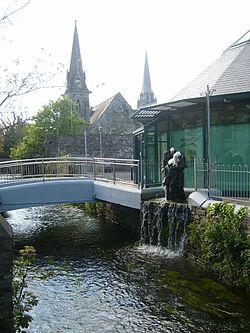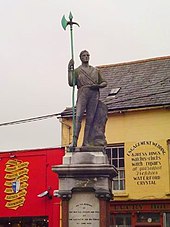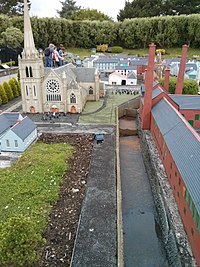Clonakilty
| Clonakilty Irish: Cloich na Coillte | |
| County Cork | |
|---|---|
 The Feagle River in Clonakilty | |
| Location | |
| Grid reference: | W381417 |
| Location: | 51°37’19"N, 8°53’11"W |
| Data | |
| Population: | 4,592 (2016) |
| Postcode: | P85 |
| Dialling code: | 023 |
| Local Government | |
| Dáil constituency: |
Cork South-West |
| Website: | clonakilty.ie |
Clonakilty is a little town in County Cork, standing at the head of the tidal Clonakilty Bay. It is a tourism hub for West Cork, helped by its gorgeous location and its own pretty appearance. The town is the largest in the west of the county after Bandon: its population as of 2016 was recorded as 4,592.
The rural hinterland is farmed mainly for dairy cattle.
The name of the village is from the Irish Cloich na Coillte, meaning 'Stone (castle) of the woods'.[1]
History
The Clonakilty area has a number of ancient and pre-Celtic sites, including Lios na gCon ringfort.
Normans settlers built castles in the area, and a number of Norman surnames survive to the present day. In 1292, Thomas De Roach received a charter to hold a market every Monday at Kilgarriffe (then called Kyle Cofthy or Cowhig's Wood), close to where the present town now stands.
In the 14th century, a ten-mile strip of fallow woodland called Tuath na gCoillte ('Land of the woods') divided the barony of Ibane (Ardfield) and Barryroe and reached the sea at Clonakilty Bay. Here a castle called Coyltes Castell was recorded in a 1378 plea roll. This was subsequently referred to as Cloghnykyltye, one of the many phonetic spellings for Cloch na gCoillte (meaning 'castle of the woods', from cloch, the Irish word for 'stone' or 'stone building', and coillte meaning 'woods').[1]
Clonakilty benefited from the patronage of Richard Boyle, 1st Earl of Cork ('the Great Earl'), who is sometimes regarded as its founder. It was this Lord Cork who obtained its charter from King James I in 1613 with the right to return members to the Irish House of Commons. The Borough of Clonakilty returned two members from 1613 to 1801; it was disenfranchised when the Act of Union came into force in January 1801.
The lands at Clonakilty were later purchased by the Earls of Shannon, another branch of the Boyle dynasty. They remained the main landlords of the town from the eighteenth century through until the early twentieth century.[2]
During the Irish Rebellion of 1641, the planted English settlers in Clonakilty fled to Bandon, and much of Clonakilty was burned.[3] English forces retook the town in 1642, in an attack where several hundred of the Confederate Irish forces were killed.[3] Some later 18th century sources stated that English forces killed "238 men, women, and children" after retaking the town.[4] The town was also the site of a battle in 1691, during the Williamite War in Ireland.[3]
During the Irish Rebellion of 1798, Shannonvale near Clonakilty was the site of the Battle of the Big Cross. It was described as "the only place in all Munster where a blow of some sort had been struck during the Rising of '98".[5]
In April 1943, a Boeing B-17 Flying Fortress was flying from Morocco to Britain when it was forced to land at a marsh just outside Clonakilty.[6] The crew (who were uninjured) said that they thought they had been flying over German-occupied Norway.[7]
In June 2012, Clonakilty was damaged by flooding.[8]
Churches
- Church of Ireland: Kilgariffe Church, a building of 1818 replacing an older church going back to 1613.
- Roman Catholic: The Church of the Immaculate Conception, in Early French Gothic style, completed in 1880.
- Methodist
The former Presbyterian Church, built in 1861, was taken over and used since 1924 as a local Post Office.
Culture
The town hosts several festivals every year, among these are The Clonakilty International Guitar Festival in mid-September, The Motion festival and The Waterfront Festival in August.
The town is known for its black pudding. Clonakilty black pudding originated in Edward Twomey's butcher shop in Pearse Street. The secret spice recipe has been handed down through the generations since the 1880s, and is still known only to the Twomey family who continue to manufacture the pudding at the Clonakilty Food Company.[9][10]
The Model Village in Clonakilty is a tourist destination in the area, and includes fully scaled models of Clonakilty and nearby towns - built on a miniature of the area's railway line.
Clonakilty's "Random Acts of Kindness Festival" was set up in 2012 by the local Clonakilty Macra na Feirme Club. The festival is held each year on the third weekend in July, with the motto: "Cut the Misery and Spread the Positivity".[11]
Clonakilty Street Carnival takes place in June of each year, and involves live music, activities and other events.
Other historical attractions in the town include the Clonakilty Museum, the Georgian houses of Emmet Square and the Micheal Collins Centre which is located a few miles east of the town. A Farmers Market takes place at Emmet Square every Friday.
Sport
- Gaelic athletics: Clonakilty GAA
- Football:
- Clonakilty A.F.C
- Clonakilty Town
- Rugby: Clonakilty R.F.C.
- Martial arts
About the village
About 15 minutes from Clonakilty and looking out over the Galley Head Lighthouse is Long Strand - a mile and a half of sand bounded by waves of dunes. The top end is used by surfers but the rest of the beach is unsafe for bathing due to a dangerous undertow.
Duneen Beach is across the bay from the right-hand side of Inchydoney beach.[12]
Outside links
| ("Wikimedia Commons" has material about Clonakilty) |
References
- ↑ 1.0 1.1 "Cloich na Coillte/Clonakilty". Irish Placenames Database. https://www.logainm.ie/9192.aspx.
- ↑ Lord Shannon's Letters to his Son, Public Record Office of Northern Ireland, 1982. Introduction, pp xxviii-xxvix
- ↑ 3.0 3.1 3.2 Lewis, Samuel (1837). "Clonkilty". A Topographical Dictionary of Ireland. Lewis. https://www.libraryireland.com/topog/C/Clonakilty-East-Carbery-Cork.php. Retrieved 12 September 2020.
- ↑ Walter Harris (historian) (1764), A collection of some of the murders and massacres committed on the Irish in Ireland since the 23rd of October 1641. With some observations and falsifications on a late printed abstract of murthers said to be committed by the Irish, London: R. S.
- ↑ C.O. Ruairc. "The Battle of the Big Cross where one hundred Irish died". http://www.failteromhat.com/southernstar/page17.php.
- ↑ "Statue for Tojo, the monkey who dropped in for a drink". BBC News. BBC. 5 April 2013. https://www.bbc.com/news/world-europe-22042258.
- ↑ "Clonakilty honours crash-landing monkey with statue". Irish Examiner. 7 April 2013. https://www.irishexaminer.com/news/arid-30590450.html.
- ↑ "Community pulls together to ensure it's business as usual in Clonakilty". Irish Examiner. 30 June 2012. http://www.irishexaminer.com/archives/2012/0630/ireland/community-pulls-together-to-ensure-its-business-as-usual-in-clonakilty-199290.html.
- ↑ "History - Clonakilty Food Co". Clonakiltyblackpudding.ie. http://www.clonakiltyblackpudding.ie/history.
- ↑ "36 hours in Clonakilty: 'Airbnb has a lot to answer for'". The Irish Times. 24 July 2021. https://www.irishtimes.com/life-and-style/travel/ireland/36-hours-in-clonakilty-airbnb-has-a-lot-to-answer-for-1.4626786..
- ↑ "Random Acts of Kindness Festival a big hit". Irish Central. http://www.irishcentral.com/news/Random-Acts-of-Kindness-Festival-a-big-hit-163329026.html.
- ↑ "10 Hidden Gems of West Cork". https://visitwestcork.wordpress.com/10-hidden-gems-of-west-cork/.
- The Battle of the Big Cross / Cath Béal a' Mhuighe Shalaigh, compiled by Tim Crowley & Traolach Ó Donnabháin; Clonakilty, Clonakilty District 1798 Bi-Centenary Commemoration Committee, 1998.
- Walks of Clonakilty town and country by Damien Enright. Timoleague, Co. Cork : Merlin Press, 2000. ISBN 1902631021


